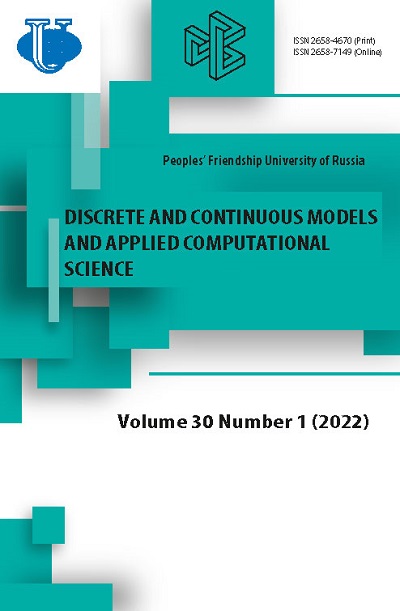On methods of building the trading strategies in the cryptocurrency markets
- Authors: Shchetinin E.Y.1
-
Affiliations:
- Financial University under the Government of Russian Federation
- Issue: Vol 30, No 1 (2022)
- Pages: 79-87
- Section: Articles
- URL: https://journals.rudn.ru/miph/article/view/30328
- DOI: https://doi.org/10.22363/2658-4670-2022-30-1-79-87
- ID: 30328
Cite item
Full Text
Abstract
The paper proposes a trading strategy for investing in the cryptocurrency market that uses instant market entries based on additional sources of information in the form of a developed dataset. The task of predicting the moment of entering the market is formulated as the task of classifying the trend in the value of cryptocurrencies. To solve it, ensemble models and deep neural networks were used in the present paper, which made it possible to obtain a forecast with high accuracy. Computer analysis of various investment strategies has shown a significant advantage of the proposed investment model over traditional machine learning methods.
Keywords
Full Text
1. Introduction The development of the financial market for cryptocurrencies in 2021 has become one of the key trends in global capital. The COVID-19 pandemic, which began in 2020, only accelerated this process, as it caused a drop in traditional markets, forcing investors to look for alternative tools and products [1]. For many, the financial market for cryptocurrencies has become such a solution. This paper studies the investor’s trading strategies in the cryptocurrency market and analyzes their effectiveness in comparison with the classical financial asset market. Their feature is the high volatility of the cryptocurrency market, so it would be natural to apply portfolio formation strategies to change the asset trend. Under these conditions, investors usually use strategies that allow them to open a position at the initial stage of a trend formation. Thus, the main goal of the work is to develop a computer system for detecting the moment of entering the cryptocurrency market and testing its effectiveness using the example of bitcoin. 2. Methods for modeling and forecasting the value of cryptocurrencies Methods for modeling and forecasting prices for financial assets can be divided into methods of technical and fundamental analysis, which determine the characteristics and form the value of an asset and features of its behavior. The first approach is based on the laws of probability theory and mathematical statistics, which allow solving various problems with different qualitative characteristics using universal methods [2]. As a rule, the first approach assumes a fundamental theory that is well formalized, understandable and logical. However, its working conditions are ’ideal’ and its application in practice does not always make it possible to make a reliable prediction. The second approach aims to test complex mathematical methods and tools to solve the first one. At the same time, methods of regression, variance, and correlation analyzes are widely used. They allow understanding the interdependencies between the asset in question and other factors. However, these methods poorly predict asset dynamics. Since the value of an asset is measured over time, it can be analyzed using econometric time series methods. However, this requires the condition of stationarity and linearity, which are not present in the real asset market. To solve this problem, the change or profitability of the asset is considered rather than its value. The use of various econometric models in trading strategies is justified in the short term, but in the long term, this approach is extremely risky due to high volatility [3], [4]. Recently, machine learning methods have become widely used for trading in financial markets due to their ability to build effective dynamic forecasting models. They solve a wide range of problems: regression, classification, clustering. Moreover, these methods show themselves best in solving such problems. We will use the following investor strategy to generate revenue in the cryptocurrency market: ⎧{{0,
About the authors
Eugeny Yu. Shchetinin
Financial University under the Government of Russian Federation
Author for correspondence.
Email: riviera-molto@mail.ru
ORCID iD: 0000-0003-3651-7629
Doctor of Physical and Mathematical Sciences, Lecturer of Department of Mathematics
49, Leningradsky Prospect, Moscow, 125993, Russian FederationReferences
- E. Y. Shchetinin, “Study of the impact of the COVID-19 pandemic on international air transportation,” Discrete and Continuous Models and Applied Computational Science, vol. 29, no. 1, pp. 22-35, 2021. doi: 10.22363/2658-4670-2021-29-1-22-35.
- E. Y. Shchetinin, Y. G. Prudnikov, and P. N. Markov, “Long range memory modeling and estimation for financial time series,” RUDN Journal of Mathematics, Information Sciences and Physics, no. 1, pp. 98- 106, 2011, in Russian.
- J. Spörer, “Backtesting of algorithmic cryptocurrency trading strategies,” Available at SSRN, 2020. doi: 10.2139/ssrn.3620154.
- A. Y. Mikhailov, “Cryptoassets pricing and equity indices correlation,” Finance and Credit, vol. 24, no. 3, pp. 641-651, 2018, in Russian. doi: 10.24891/fc.24.3.641.
- A. Geron, Hands-on machine learning with Scikit-Learn, Keras, and TensorFlow: concepts, tools, and techniques to build intelligent systems, 2nd Edition. O’Reilly Media, Inc., 2019.
- G. G. Ognev and E. Y. Shchetinin, “Deep neural networks with LSTM architecture for predicting financial time series,” in Information and Telecommunication Technologies and Mathematical Modeling of High-Tech Systems 2020 (ITTMM 2020), in Russian, Moscow, Russia, April 13-17, 2020, pp. 280-283.
- A. Arratia and A. X. Lopez-Barrantes, “Do Google trends forecast bitcoins? Stylized facts and statistical evidence,” Journal of Banking and Financial Technology, vol. 5, no. 1, pp. 45-57, 2021.
Supplementary files















